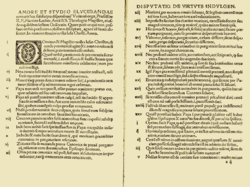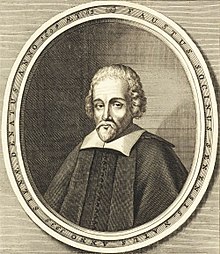Reformation in Italy
| Part of a series on the |
| Reformation |
|---|
 |
| Protestantism |
The
History of the Italian Reformation
Pre-Reformation Italy
During the 12th and 13th centuries a wide variety of religious dissidents appeared in Northwestern Italy and in Rome (like the
A Dominican friar, Girolamo Savonarola (1452–1498), is regarded as the predecessor of Martin Luther in Italy:[2] he stigmatized the debauchery and abuses of the Catholic clergy, as well as demanding a "moral revival" and the destruction of statues and images at churches. However, in contrast with Luther, Savonarola did not gain the protection of influential patrons, and his action was of short duration. It was limited only to Florence, and soon Savonarola was hanged and burned.[3] Savonarola's Florentine contemporaries Marsilio Ficino and Giovanni Pico della Mirandola attempted what has been termed a “Hermetic Reformation,"[4] but their Hermetic and Neoplatonic doctrines did not result in the emergence of a Protestant denomination.
Prof. Dr. Emidio Campi writes that the history of the Italian Reformation has been not yet thoroughly examined.[5] Naples was one important centre of the Reformation. There, at the end of the 15th century, a so-called Spirituali circle was formed. It was concentrated around Spanish immigrant Juan de Valdés, who propagated Christian mysticism. In the 16th century, Venice and its possession Padua were temporarily places of refuge for Italian Protestants. These cities, along with Lucca, were important centres of the Italian Reformation because they were easily reached by new religious ideas spreading from the North. However, Protestantism there was quickly destroyed by the Inquisition. Italian Protestants fled mainly to German duchies and to Switzerland.[1]
Basis of the Italian Reformation
Causes of the Italian Reformation were diverse: the precociousness of humanism, associated with the Italian revival; the rule of foreign powers (e.g. Spain in southern Italy, the Holy Roman Empire in the North), which were propagating other forms of Catholicism contrary to the Italian tradition; need of a deeper and more personal relation with God; a defence of Italian democratic and republican traditions against authoritarian monarchies in Spain and Germany; reaction to the ostentatious wealth and immoral conduct of the Catholic clergy, particularly Pope Alexander VI, who openly supported corruption and nepotism.[6] The papacy was often accused (among others by Niccolò Machiavelli) of supporting the political division of Italy.[6]
Rise of Protestantism in Italy
Rise of Lutheranism
In the 1520s, soon after publication of the first letters of Martin Luther, the first few Italian Lutherans appeared (e.g. Pier Paolo Vergerio, Aonio Paleario). However, the effect of Lutheranism was minimal because Luther wrote in German and directed his mission mainly at Germans, and the Church censorship in Italy was very effective.[6]
in Neapolitan territory.All mentions of Lutheranism were immediately destroyed: in 1530 Antonio Bruccioli was expelled from Florence because he had cited works of Luther and Martin Bucer. Later he rendered the Reformation great service by elucidating and printing Biblical writings in the Italian language. He was repeatedly brought to trial, and died in prison in 1566.[7] In 1531 Luther's theses were discussed at the University of Padua. It was the only known case of such an academic discussion in Italy.[1]
Rise of Calvinism, Anabaptism, and Nontrinitarianism
Italian Protestants quickly radicalised their views under the influence of religious persecutions, and started propagating
About 1528 many French radical Protestants (among others
Revival of Waldensianism
Causes of the Italian Reformation's collapse
The Italian Reformation collapsed after only about 70 years of existence because of the quick and energetic reaction of the Catholic Church. In the summer of 1542 the Italian Inquisition reorganized itself in order to fight Protestants in all Italian states more effectively.
As a result of this threat the majority of Italian reformers escaped to countries in Northern and Eastern Europe, such as Poland, where in Kraków the influential group of Italian Unitarians came into existence, supported unofficially by the Queen of Poland, the Italian-born Bona Sforza.
About 1600, almost all Protestantism practically ceased to exist in Italy, with Catholicism remaining the religion of the Italian states.
In Italy the Catholic Church from its beginning effectively fought diverse heresies. Thus Italian religious reformers did not have a chance for wider activity and for propagating their views. Italian princes quickly stopped supporting the Reformation, because it could deprive them of profitable clergymen positions (like
Another important cause of the Italian Reformation's collapse was the aggressive politics of the Holy Roman Empire toward Italian states. Italian princes identified the Reformation with this threat, and their belief was confirmed by, among other events, the Sack of Rome in 1527.
The first translation of the Bible into Italian language by Giovanni Diodati of Lucca was published in 1603, after the fall of the Reformation in Italy, and for this reason it only contributed to the development of Protestantism outside Italy, mainly in Italian-speaking cantons of Switzerland (Ticino and Grisons).
Impact of the Italian Reformation

In Italy the Reformation exerted almost no lasting influence,[citation needed] except for strengthening the Catholic Church, unlike the essential impact it had on other European countries (Switzerland, Germany, Bohemia, Hungary, and Transylvania among others). Many Italians were outstanding activists of the European Reformation, mainly in the Polish–Lithuanian Commonwealth (e.g. Giorgio Biandrata, Bernardino Ochino, Giovanni Alciato, Giovanni Battista Cetis, Fausto Sozzini, Francesco Stancaro and Giovanni Valentino Gentile) who propagated Nontrinitarianism there and were chief instigators of the movement of Polish Brethren.[citation needed]
Biblical Unitarian Movement
On the fringes of the Protestant Reformation there is the Biblical Unitarian Movement.
Italian Protestant reformers
- Lelio Sozzini
- Giovanni Valentino Gentile
- Pier Paolo Vergerio
- Pietro Martire Vermigli
- Girolamo Zanchi
- Giovanni Diodati
- Francesco Turrettini
- Aonio Paleario
References
- ^ a b c d e f (in Italian) La Riforma in Italia Archived May 13, 2013, at the Wayback Machine (accessed 21.06.2010)
- ^ (in French) Le protestantisme en Italie et en Espagne (accessed June 21, 2010)
- ^ "Savonarola". March 4, 2015.
- ISBN 978-1-4610-9382-4
- ^ Italian Reformation I (accessed June 21, 2010)
- ^ a b c Italy at the time of the Reformation (accessed June 21, 2010)
- ^ a b c ITALY, THE REFORMATION IN. (accessed June 23, 2010)
- ISBN 978-0-14-028534-5.
- Servetus
- English capitalisationcites source: L. Sue Baugh Essentials of English Grammar: A Practical Guide to the Mastery of English (9780844258218) Second Edition 1994 p59 "Religious Names and Terms: The names of all religions, denominations, and local groups are capitalized." Uncapitalized: Ankerberg.
- ^ Tuggy, Dale, (2009). Stanford Encyclopedia of Philosophy[permanent dead link]. Accessed 10-30-2010
Bibliography
- Caponetto, Salvatore. The Protestant Reformation in Sixteenth-Century Italy, Anne C. Tedeschi, John Tedeschi (transltr.), Thomas Jefferson University Press, Kirksville, 1999.
- Church, Frederic C. "The literature of the Italian reformation," Journal of Modern History (1931) 3#3 pp: 457-473 in JSTOR.
- Elton, G.R. ed. The New Cambridge Modern History, Vol. 2: The Reformation, 1520-1559 (1958) pp 251–74
- MacCulloch, Diarmaid. The Reformation (2005) pp 401–17
- Massimo Firp, "The Italian Reformation" in R. Po-Chia Hsia, ed.A Companion to the Reformation World (2008) pp 169–84.
